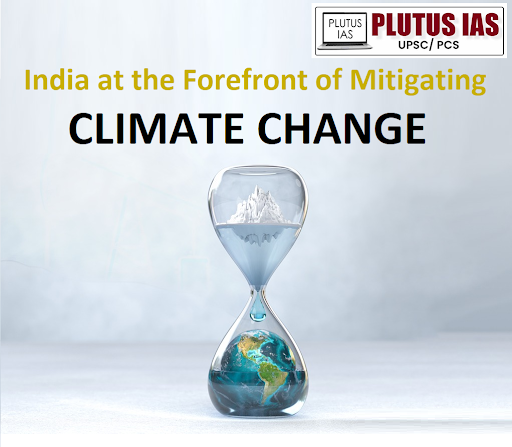19 Sep India’s pathway to Net Zero Carbon emissions by 2070
This article covers “Daily Current Affairs” and topic details of India’s pathway to Net Zero Carbon emissions by 2070.
Syllabus mapping:
GS-3: Environment and disaster management: Climate change and India policies.
For Prelims:
What are Net Zero Emissions, NDCs, India’s five principles, and government policies and programs related to climate change?
For Mains:
How India is managing its responsibility under the international obligations? What are various policies/Strategies and their objectives, challenges, and issues faced by these policies and strategies, long-term policies to achieve net zero emissions by 2070?
Why in the News?
Recently NITI Aayog CEO said that NITI Aayog is working on strategies to achieve the target of Net Zero Emission by 2070.

What is Climate Change?
Climate change refers to long-term changes in temperature and weather patterns. While such shifts can occur naturally due to factors like variations in solar activity or volcanic eruptions, human activities have been the primary cause of climate change since the 1800s. The burning of fossil fuels—such as coal, oil, and gas—has led to significant greenhouse gas emissions. These gasses act like a blanket around the Earth, trapping heat and raising global temperatures.

Net- Zero emission or carbon neutrality:
Net-zero carbon emissions refer to the balance between the amount of greenhouse gasses emitted into the atmosphere and the amount removed from it. Achieving net zero means that any carbon dioxide (CO2) emissions produced by human activities are balanced by an equivalent amount of CO2 removed from the atmosphere, resulting in no net increase in atmospheric CO2 levels.
India and Climate Change
Climate change is a global challenge and requires collective global action to avert and minimize the impacts of climate change. International efforts to address climate change are guided by the United Nations Framework Convention on Climate Change (UNFCCC) and its two instruments, namely the Kyoto Protocol and the Paris Agreement. As a responsible global player, India is a Party to the UNFCCC and its instruments.

Key Commitments:
At the COP26 Summit in Glasgow, the Hon’ble Prime Minister of India made five key commitments to combat climate change:
1. Net Zero Emissions by 2070: India aims to achieve net-zero emissions by the year 2070.
2. 50% Renewable Energy by 2030: By 2030, India will ensure that 50% of its energy requirements come from renewable sources.
3. Reduce Carbon Emissions: India will decrease its total projected carbon emissions by one billion tons by 2030.
4. 500 GW Non-Fossil Energy Capacity: India plans to expand its non-fossil energy capacity to 500 GW by the end of 2030.
5. Reduce Carbon Intensity: The nation will aim for a reduction in carbon intensity of over 45% by 2030, compared to 2005 levels.
Various initiates and policies by the government of India to deal with Climate change:
Domestic Level initiatives:
1. The National Action Plan on Climate Change (NAPCC) serves as India’s comprehensive policy framework for climate action, outlining strategies for both adaptation and mitigation.
2. The National Mission on Sustainable Transport is in development to promote efficient, cost-effective transportation solutions that consider environmental, social, and economic factors.
3. National Biodiversity Action Plan: Aims to protect and conserve biodiversity, which is vital for climate resilience.
4. Schemes like Green Hydrogen Mission, PM Ujjwala, and Soil Health Card, all are directed toward reducing carbon emissions.
International Level Initiatives:
1. Mission Life: It primarily focuses on the reduction of the carbon footprint of individuals through eco-friendly practices.
2. International organizations like the International Solar Alliance, and Global Biofuel Alliance, formed by India’s active role aimed at working to reduce the dependency on fossil fuels.
3. Kigali amendment: This aims to phase out the global warming chlorofluorocarbon substances.
4. Global stocktake: Under the Paris Agreement India presented its first-ever global Stockstake in 2023 at COP 28.
5. Coalition for Disaster Resilient Infrastructure (CDRI): An initiative to promote resilience in infrastructure systems to climate-related disasters, fostering international cooperation.
6. Bharat Stage Emission Standards (BSES): Aligning vehicle emission norms with international standards to reduce air pollution and improve air quality.
What are the challenges that Limit India to achieving net zero emissions?
1. Development vs climate change: India is a developing country even though its per capita emission is less overall. India is the third largest emitter in the world.
2. Climate finance: A major issue not only for India but all developing countries is climate finance, Most countries including India are lacking in climate finance.
3. Technology Transfer: India lacks the technology to mitigate and adapt to the effects of climate change.
4. Vulnerability: According to the IPCC report, India is one of the most severely vulnerable countries.
5. Lack of international collaboration: global countries are not on the same page when it comes to climate change. India is finding it difficult to navigate these challenges.
6. Dependency on Fossil fuel: Still India is dependent on coal-based energy sources. Around 50 percent of electricity is produced by using coal-based resources.
7. Slow transition: The slow transition to renewable energy and green energy is slow and steady vis to the climate change effect.
8. Agricultural Challenges: Agriculture, a major sector in India, faces pressures from climate change itself. Transitioning to sustainable practices while ensuring food security is complex.
9. Policy and Regulatory Framework: Inconsistent policies and regulatory barriers can slow down the implementation of renewable energy projects and climate initiatives.
Steps to Achieve the Net-Zero Emission Target by 2070:
1. Green Energy: India’s path to achieving this target passes through green energy initiatives like Green hydrogen are welcome steps in this regard.
2. Harnessing the renewable energy potential: India can harness the potential of its solar and wind energy to achieve more renewable energy from these sources. The National Solar Mission and Wind Mission are harnessing these potentials.
3. Collaboration with countries: India and other countries like the US have a clean energy mechanism to collaborate on climate change issues.
4. Sustainable agriculture practices: The use of sustainable practices such as hydroponics and climate-smart agriculture is needed to reduce GHG emissions.
5. Investment in Climate Resilient Infrastructure: the green steel industry and charcoal roads are the beginning of such climate-resilient infrastructure. The special allocations of funds are such initiatives that would help to reduce the climate impacts.
6. Leadership at the international level: India’s International Solar Alliance and other international-level initiatives will help India get the needed finance and help other third-world countries.
7. Technology and innovations: The fight against the climate remains empty if India ignores the technology. So India needs to be more focused on technological developments.
8. Active citizenry: active and aware citizens can reduce the emissions of the GHG and would help to reduce the carbon footprints.
9. Preservation of biodiversity: India is one of the top biodiverse countries in the world and this diversity needs to be protected. The forest can act as the natural reservoir for the carbon. India’s forest policy also aims to cover ⅓ area of India under the forest. The mission of Sustainable Habitat needs to be implemented at the grassroots level.
Conclusion:
India is the only G20 nation that achieved its commitment under the Paris Agreement well before the time and the need is to keep this momentum continuing. The initiatives like LIFE Mission, and ISA are in the right direction. The NITI Aayog strategy will help India set up short-term and long-term goals to achieve the target by 2070.
Download plutus ias current affairs eng med 19th Sep 2024
Prelims Question:
Q. Consider the following techniques:
1. Ocean fertilization
2. Mineral Weathering
3. Use of the biochar
4. Use of gray carbon and hydrogen
5. Use of sulfur mirrors
6. Methane hydrate use
7. Use of membrane filters.
How many of the above-mentioned techniques can help India achieve its target of net zero emissions by 2070?
A. Only two
B. Only three
C. Only four
D. Only five
Answer: D
Mains Question:
India has made a strong commitment to achieving net-zero emissions by 2070, but there are several challenges to address first. What are these challenges, and what short-term and long-term strategies can be implemented to achieve this ambitious target?
(250 words 15 marks)



No Comments